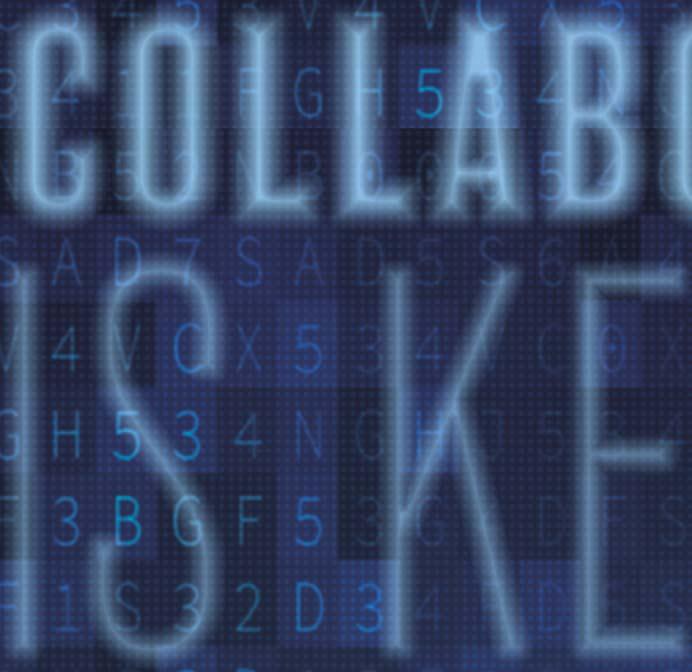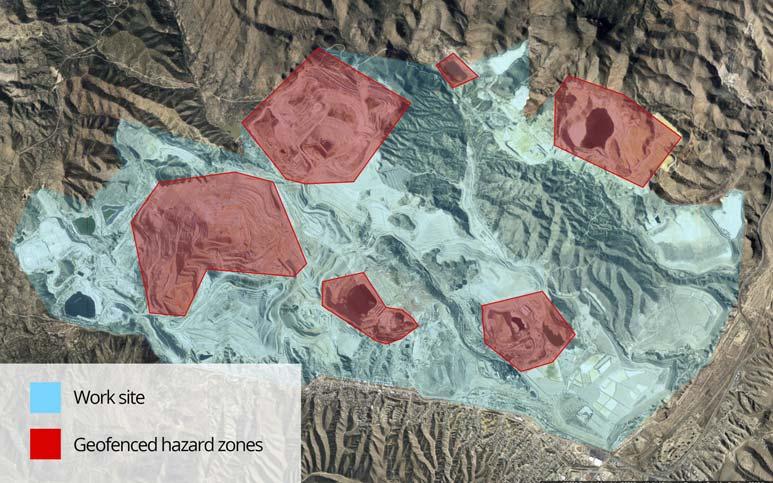
9 minute read
Collaboration Is Key


Sean Timmins, Orion, USA, considers fi ve ways frontline collaboration is key to transforming mining operations.


Rising costs, supply chain constraints, and the ongoing need for sustainable development and growth are placing tremendous pressure on mining operations to increase workforce productivity, while emphasising the tandem priority of improved workplace safety. Today’s mining companies need new methods and new ways of thinking to meet these ever present operational and workforce imperatives.

The solution: digital transformation


Embracing digital transformation and new digital technology provides a long-term path to building resilient businesses focused on improved productivity and safety. In fact, BHP stated in its 2020 annual report: “Technology is a key lever for BHP to improve frontline safety, increase productivity, reduce cost, build capability, and accelerate value creation.”1
Mine sites are some of the most demanding operating environments in the world and require unique approaches to realise the benefits of digitalisation. Complex underground tunnel systems require careful planning and critical safety measures, and the footprint of opencast mines continually


changes over time. Workers must always be heads-up and aware of their surroundings and heavy machinery.
Mining enterprises seeking to benefit from digital transformation need to equip their frontline workforce with modern communication technologies designed for these environments. Geologists, surveyors, truck operators, machine operators, mechanics, electricians, technicians, blast crew members, supervisors and more, all of these frontline mine workers need the ability to communicate and connect to others off and on-site.
However, mining enterprises need more than just reliable communications to enjoy the advantages of digitalisation. They need a connected, empowered frontline workforce to truly innovate and drive digital transformation organisation-wide. Today’s collaboration technology delivered on secure push-to-talk (PTT) smart devices meets this need to transform the frontline mining workforce by modernising communication and redefining best practices for safety and productivity.
The following are five ways mining companies can transform their frontline operations when they equip their workforce with collaboration technology. Increased productivity with process automation
Operational command and control
Mining operations are inherently complex and oft en operate in remote locations. These remote mine sites rely upon a distributed workforce with pit-to-port operations and logistics managed hundreds of miles away. Mining leaders need centralised visibility that connects a distributed workforce and operations to their organisation in real time – whether they are in the mine or loading trains in the railyard.
Collaboration technology, available both on PTT-enabled smart devices and browser-based dispatch consoles, enables managers and supervisors to observe communication traff ic and coordinate teams in real time, no matter where they are. Managers also gain organisational visibility, connecting directly to headquarters and regional or local team members.
At the mine site, opencast mines cover miles of ever-changing terrain, and underground mines are a complex network of tunnels hundreds of metres deep that prevent visibility into worker locations. Real-time location and mapping of workers are critical to eff ectively overseeing daily operations and responding to emergencies.
Open mining location services are enabled based on global positioning systems (GPS) and other sensor data on handheld devices. Subterranean location services can be enabled with the availability of mesh nodes, access points, or Bluetooth beacons within the mine.
Advanced location services enable managers and supervisors to track the location of workers for safety, to reassign tasks, redirect traff ic, or provide emergency assistance. Advanced location services increase visibility into where and what workers are doing at any given time, especially in urgent situations, increasing coordination and accountability. Knowing the real time locations of workers is a critical component of saving lives when the unexpected happens or things do not go as planned.
Digital transformation with intelligent collaboration solutions off ers new opportunities to increase safety and productivity with process automation. Workers in dangerous work areas are able to remain heads-up and focused on the task at hand. Voice-first collaboration technology available at the point-of-work on smart devices automates standardised checklists, operating procedures and compliance forms, eliminating paper checklists and recording and logging answers for analysis, response, and review. When process automation removes the burden of routine tasks, workers can focus on higher-value tasks. For example, paper-based checklists are oft en manually entered into a computer, consuming valuable time and wasting resources that could be spent on higher-value activities. In other cases, these checklists remain on paper, never entered into databases, which leads to valuable information that could be used for analysis and continual process improvement being neglected. Seamlessly digitalising these records enables supervisors to identify common issues that, for example, can cause equipment deployment delays or shift -change bottlenecks. Here is an example seamless digitalisation in action. Say, a vehicle operator conducts a routine equipment inspection of a haul truck or power shovel prior to operation and notices that the machinery needs maintenance. Using a voice-activated workflow, the operator is able to log the issue, initiate a work order, deploy maintenance personnel, and update their manager. Automated maintenance workflows save valuable time across the organisation for expensive equipment, such as: conveyors, ventilation systems, machinery, and more. Haul trucks and power shovels are multi-million dollar pieces of equipment. Every minute they remain out of service can cost companies thousands of Figure 1. Geofenced voice alerts issue instant instructions when workers dollars, but automated processes can help reduce enter geofenced hazard zones. this machine downtime.

In another example, when a driver moves a haul truck out of a geofenced mining area, conveyor operators can be automatically notified of its pending arrival and activate the conveyor. When the hauler re-enters the geofenced mining area, the shovel operator can be informed of which truck is returning. Automating communication processes saves time and increases productivity.
Intelligent collaboration solutions also automate language translation, increasing productivity by allowing workers to receive communications in their own language. Language translation capabilities are more important than ever, as global mining companies rely on increasingly diverse teams and international contractors.
Increased safety in urgent situations
Rapid response and real-time information in urgent situations are mission-critical for the mining industry, and key to increasing miner safety. Modern collaboration technology helps workers in dynamic situations by providing instant and accurate intelligence with always-on, automated panic alarms, man-down alerts and lone worker safety protocols, which can be automatically or manually triggered by commands, events, or actions.
For example, in the event that a lone worker is injured or unable to move, they could simply say “help-help” to trigger a predetermined workflow that alerts and deploys the closest workers, safety personnel, medics, and site managers to the worker’s whereabouts. The system alerts personnel and notifies supervisors or first responders, whether they are off or on-site. Intelligent collaboration solutions record the metadata from incidents, tracking and storing information like response times, location, workers on-the-scene and all communications, in order to simplify and automate incident reporting and auditability.
Automated workflows can also be initiated by the movements of workers. A lack of detected movement by workers could be indicative of incapacitation. Sustained non-movement can trigger a workflow to request a voice check-in from the worker, prompt personnel in the vicinity to investigate, or deploy safety resources to that worker’s location.
Similarly, dangerous areas or work zones can be geofenced to automatically detect workers’ entrance or departure and initiate safety check-ins or automated voice-walk-throughs of checklists. If a worker fails to respond, remains in the area for too long or stops moving, workflows can trigger safety protocols to automatically send assistance without requiring a verbal response. Limited-access areas can also be geofenced to notify when personnel enter or leave a secure location.
Safety workflows are always-on, ready to alert supervisors and team members to a worker’s exact location, deploy immediate assistance, and record and archive all activity for subsequent review.
Empowering workers with information
In many places around the world, the mining workforce is shrinking as workers seek jobs in other sectors. One example of this can be found in the Canadian-based Mining Industry Human Resources Council’s ‘Mining Year in Review: National Outlook for 2021’, which notes that enrolment in Canadian undergraduate programmes focused on mining engineering fell by 33% from 2015 to 2019.2
Finding a skilled workforce will continue to be a challenge for the industry, forcing companies to adapt innovatively. Collaboration tools connect workers with back-end systems and resources for information retrieval, amplifying intelligence at the point of work.
Intelligence amplification reduces training time and ensures all workers have access to critical information, wherever they are. Employees, including new workers and contractors, can have immediate access to the information they need to do their jobs and get up to speed quickly. Managers can also share their collaboration platform with contractors, allowing them to access critical information quickly and communicate or integrate with existing groups, subject matter experts (SMEs), backend systems, and knowledge bases.
Seamless operations in edge and challenging environments
Connectivity for PTT on smart devices, applications, and browsers will always pose unique challenges for organisations operating in remote locations. Underground mines with shaft s, stopes, ramps, and pillars create further connectivity challenges. Opencast and underground mines require careful consideration of available networking technologies to ensure communications are reliable and always on.
Mining operations have the potential to lose millions due to downtime from technology not designed for remote, hostile environments.
Soft ware-as-a-service-based solutions, such as collaboration soft ware, require internet connectivity – whether it is with 3G or LTE, Private LTE, Wired Backhaul, Satellite Dish, or BGAN. When these are not available, the solutions must be deployed on-site, or on local networks. In either instance, devices on-site will need to use WiFi in areas where 3G and LTE are unavailable, including underground.
Collaboration technology for mining organisations must be able to operate on the edge with functionality that is highly available, secure, and reliable.
The future of collaboration in mining
As mining organisations invest in digital initiatives across their supply chain, they will only realise the full benefits of organisational transformation if they invest in technology that empowers their frontline workforce.
A connected workforce from pit-to-port, or from the mine site to headquarters, creates an agile, digital enterprise ready to respond to evolving needs and capitalise on opportunities. Today’s mining enterprises have the opportunity to transform their operations and gain a competitive advantage with intelligent collaboration technology.
References
1. 'Annual Report 2020', BHP, bhp.com/investor-centre/annualreport-2020/ 2. 'Mining Year in Review: National Outlook 2021',
Mining Industry Human Resources Council, https://mihr.ca/news/ mining-year-in-review-national-outlook-2021/










